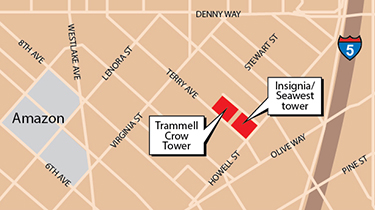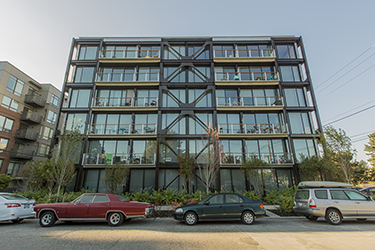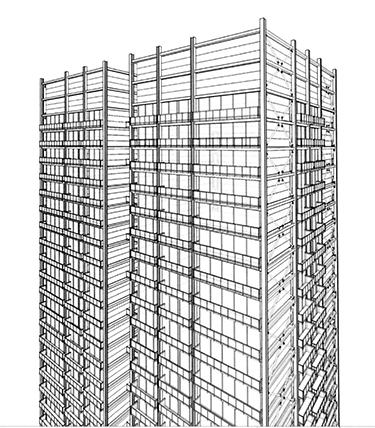|
Subscribe / Renew |
|
|
Contact Us |
|
| ► Subscribe to our Free Weekly Newsletter | |
| home | Welcome, sign in or click here to subscribe. | login |
Construction
| |
December 14, 2015
35-story tower at 1800 Terry may be built using modular system
Journal Construction Editor
Seawest Investment Associates is looking at going tall with modular construction — 35 stories tall.
Documents submitted to the city show that Seawest and Insignia 2006 LLC want to build a 360-unit residential tower at 1800 Terry Ave., where Seattle Vault Self Storage is located.
The 456,000-square-foot tower would have 5,000 square feet of ground-floor retail and 260 parking stalls, most of them underground.
A preliminary drawing from a pre-submittal conference shows two modular towers connected to create one complex. Other documents say the complex could be built with the same modular “kit of parts” method that was used on a new apartment building called 47+7 at 4558 Seventh Ave. in the University District.
Matt Aatai of Kirkland-based Seawest said, “We have looked at that concept, but no decision has been made.”
Aatai said details are still being worked out, including construction and design, and no schedule has been set.
Sustainable Living Innovations, a division of the Seattle architectural firm CollinsWoerman, created the patented modular system that was used on 47+7 and the firm is listed on documents for the Terry tower. CollinsWoerman designed 47+7 and is working on Terry.
A spokesman from CollinsWoerman declined to comment, and a representative from SLI didn't return phone calls.

47+7 got financial backing from Bellevue-based Wallace Properties and was built by Sellen Construction. It is six stories and contains 24 units.
Rick Osterhout of SLI told the DJC in 2013 that his company had met criteria set by the city to go up to 12 stories without fireproofing its unique buildings. At the time, he said the city required that each SLI project be considered on its own merits.
Steve Pfeiffer, engineering and technical codes manager for the city, said the city's main concern is the end product, not how a tower goes together. He said there are no special hoops for innovative structural systems to go through, but some items such as electrical systems may need further study.
Pfeiffer said the city has been told SLI's structural system meets code, and will review that.
Pioneering project
For 47+7, crews constructed the building systems, walls, cabinets and windows off-site, and then loaded them onto concrete floor slabs that were poured on-site. A computerized hydraulic lift pulled each loaded slab up through a prefabricated steel frame. The initial slab was bolted to the top of the frame and the components installed. The process was repeated for each floor below.
“For such a pioneering project it's incredible how well it came together,” said Kevin Wallace, president and CEO of Wallace Properties.
Wallace said there was an “extraordinary” learning curve with 47+7, but SLI put a lot of effort into the system before construction, so a lot of problems were ironed out early.
Wallace said his group is looking at using the SLI system on another project, and hopes to announce something next year.
Bob McCleskey, chairman and CEO of Sellen Construction, wrote in an email that the team worked on many issues to refine the process during construction of 47+7, and those solutions will be used in the next iteration of the system.
“It was not the most efficient process,” McCleskey wrote, “but given that this was a prototype we knew it would be an evolution.”
“(We) knew going in that our industry needs to push hard to develop more of an assembly mentality — fabricating as much as possible off-site and assembling it on the job. It's safer, faster, better and more cost effective. We didn't get all the way there on this project but it's a big move in the right direction,” he said.
Sellen is not working on the Terry tower.
DCI Engineers was the structural engineer for 47+7, but the firm declined to comment for this story. DCI's website describes 47+7 as “a viable plug-and-play construction solution.” It said the component-based design for 47+7 was competitive with conventional wood-built construction.
It's unclear if the system would save money when used on a high rise compared with structural steel or concrete.
But plans for the 1800 Terry tower apparently aren't going over well with one of its neighbors.
Trammell Crow Co. has complained to the city that Seawest's proposed building would encroach on Trammell's 21-story office tower called Midtown21 that is under construction now. Midtown21 shares the half block bordered by Terry Avenue and Stewart and Howell streets.
Howard S. Wright is building the 365,000-square-foot Midtown21 for joint venture partners Trammell and MetLife.
In a letter to the city dated Oct. 26, a representative of 1 Bond Tower LLC wrote that they were concerned that there would not be enough space between their tower and Seawest's complex. State records list the governing member of 1 Bond Tower LLC as TC Bond Tower Member LLC, which has the same address as Trammell Crow's Dallas headquarters.
The letter, from attorney T. Ryan Durkan, stated that there was an agreement in place, and that the city should not waive tower spacing requirements without permission from Trammell Crow.
Durkan is with Hillis Clark Martin & Peterson in Seattle. She didn't respond to a request for comment.
The five-story Seattle Vault would be demolished to make way for the Terry tower. It was built in the 1960s as an office building with about 94,000 square feet.
County records show that Seawest and Insignia bought the site in August 2007 for $15.6 million from an entity run by Bosa Properties. The Bosa entity bought the site in January 2006 for $7.6 million from an entity run by Joseph Brotherton and William Summers.
Seawest's website says that in 2011 Seawest and Insignia converted the former headquarters of Regence Blue Shield to self-storage. Atcon Construction Co., an arm of Seawest, was the general contractor for the conversion.
The DJC reported in 2011 that Insignia 2006 was owned by Leisure Care CEO Dan Madsen. Leisure Care manages and develops retirement and assisted-living projects.
Benjamin Minnick can be
reached by email or by phone
at (206) 622-8272.
Related Stories:




